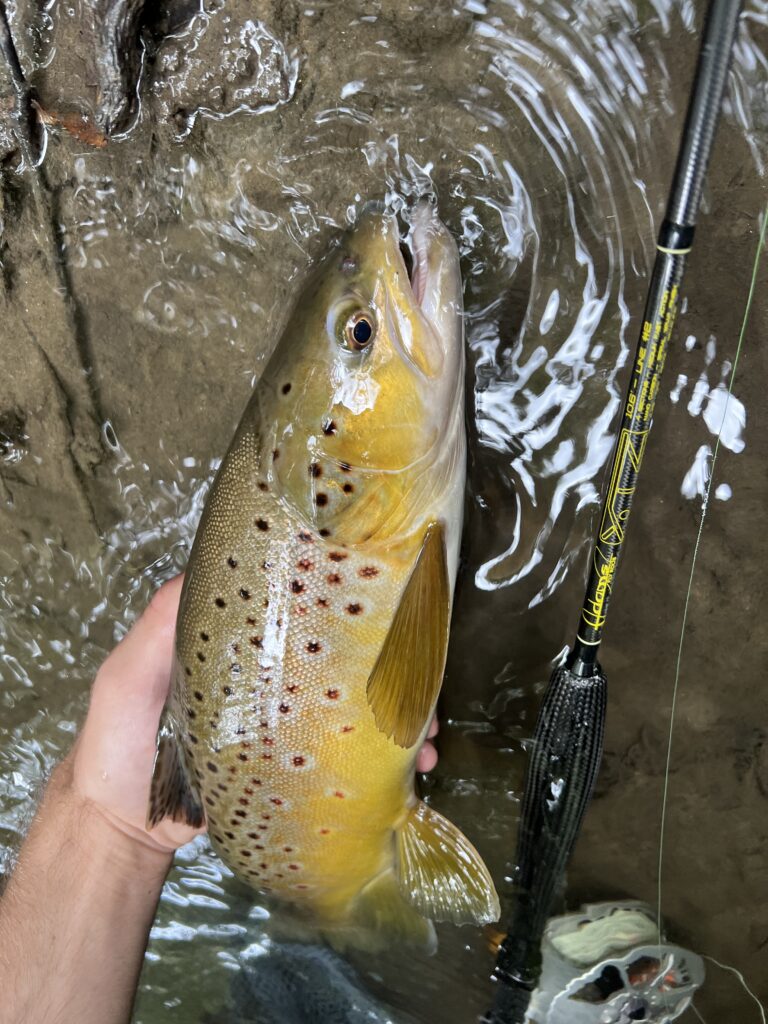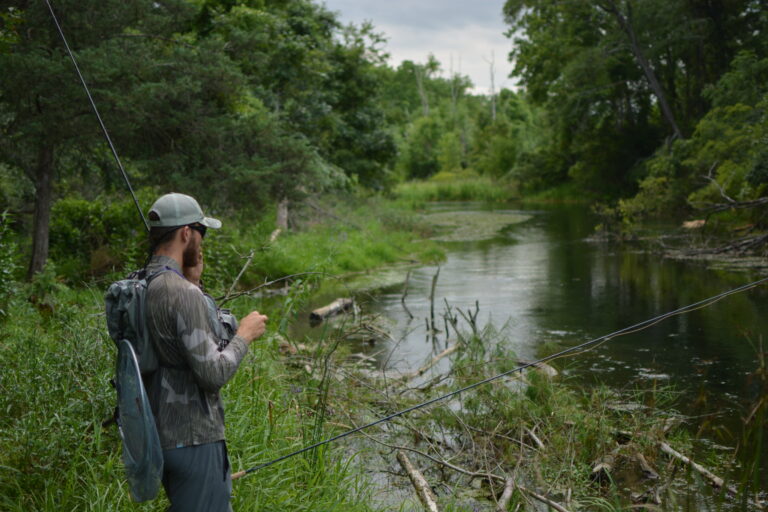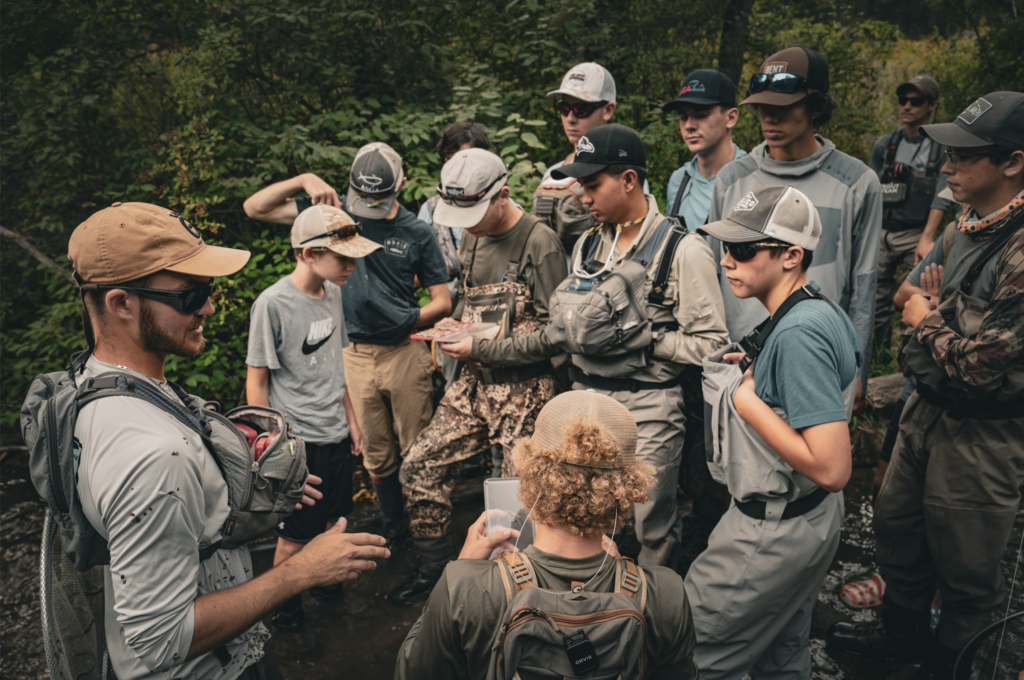Fly Fishing The Little Juniata
Little Juniata River Overview
The little Juniata is one of the “big four” Central Pennsylvania limestone streams. It’s a favorite amongst anglers for its plentiful access, epic hatches, and incredibly healthy population of fish, some of which grow larger than twenty inches. Of all the Central Pa limestoners, none quite embody Pennsylvania fishing quite like the Little J. With its limestone littered banks, heavy, tinted flows, and numerous century old bridges, you won’t find a more classic river in the state.
The Little Juniata begins just north of Altoona, Pa. It picks up a lot of water from a handful of tributaries as it flows northeast towards the town of Tyrone, where it meets Bald Eagle Creek, and takes a nearly ninety degree turn southwest. It then takes runs through the small towns of Spruce Creek, where the world renowned tributary of the same name dumps in, and Barree. It finally ends where it meets the Frankstown Branch to form the main Juniata River, just north of Petersburg. The Little Juniata holds trout through the entirety of its thirty two mile course. Though you’ll mostly find wild brown trout, there are a decent number of stocked rainbows that drop down from the stocked section above Tyrone, and a few massive fish that swim in from the private water on Spruce Creek every now and then.

Accessing the Little Juniata
Luckily for anglers, there’s ample access all up and down the J. On the lower end of the river, there are plenty of pull-offs from Barree down to the river’s mouth, mainly off of Barree Road and Allison Road. Above Barree, however, the roads end. This section of the river is known as the Gorge or Rothrock section (as the river is bordered by Rothrock State Forest. It can only be accessed via walking up the river or train tracks.
If you follow the river through the gorge, you’ll pop out in the small town of Spruce Creek. This area is again accessible by road, with a popular parking area at th white church right next to the bridge in town. There are numerous pull-offs as you drive up the river along Union Furnace Road, and a large parking lot at the quarry at the roads end. After this, access is again
Fishing The Letort
The Letort has not gotten its reputation of being one of Americas hardest rivers for no reason. It can be an exceptionally difficult fishery for a number of compounding reasons. Probably the most difficult aspect is positioning. The Letort averages about three feet of water deep, then an additional foot of weeds, which lay over one or two feet of thick mud. There are virtually no good areas to wade, so nearly all fishing has to be done from the bank. The fish are warier than most, and fishing to them in high clarity water from a elevated bank makes getting into position to make a cast seemingly impossible. On top of this, despite the streams notoriety, there are few well worn trails along its banks to help you get from place to place.
The river is also set up in a way that makes getting effective drifts hard. It’s very weedy, with only small channels through the vegetation in most places. The weeds cause highly variable, swirling surface currents that make getting a drift, eithe ron the surface or beneath it difficult. Couple that with the fact that you’re limited in the positions to can get to to set the drift up, and you’ve got yourself an extra hard fishery.
The Letort can be broken up into three main sections: the Lower Letort, the Town Stretch, and the Upper Letort. The Lower Letort runs from the its confluence with the Conodoguinet to the Carlisle Barracks. The Town Stretch runs from above the Barracks to the Route 81 Highway Bridge. Finally, the Upper Letort is everything above the Route 81 Highway Bridge, though realistically the fishing of any interest ends at the upper Bonny Brook Access. From just above the Bonny Brook Bridge down to just above Letort Park is managed as a “Heritage Water” fly fishing only section.
Access to these sections is fairly good. The Lower Letort has the least access, with some points in the form of small pulloffs on nearby roads. It can take a lot of walking and bushwhacking to access portions of the river between these points, and some landowners are not amenable to anglers crossing their property. The Town Stretch has very good access in the form of public parks that encompass most of the river here. Biddle Mission Park and Letort Park, and Lamberton Middle School are the main accesses. From the middle school, you can access the Letort Spring Run Nature Trail, which parallels the Letort all the way to Bonny Brook. On the upper river, the accesses are Vince’s Meadow, which is a nicely maintained fishing access, and a lot off of Bonny Brook Road near where it crosses the creek. The stretch that follows the nature trail is the most popular and manageable to fish.

The Letort is best fished by sight fishing. The water is usually clear enough to see any fish feeding in accessible areas outside the weeds. Carefully crawling into position and targeting these fish is the easiest way to be sure you’re making a presentation to fish you havn’t already spooked. You’ll often get only one or two shots at these trout, so you have to make them count. Starting off with 5x or 6x tippets and a properly weighted fly is key to getting an eat. It can take many days learning the Letort and where its fish feed before you can sneak up on one. Blind nymphing can work in some of the rivers large holes, though these are few and far between, and if this is your plan for the day, you’ll quickly run out of water.
Hatches are not particularly easy to pin down. You may find some BWO’s and sulfurs if you’re lucky, and tricos in the early mornings from July to September. Rises are still normally sporadic, but if you run across a decent hatch yo may find a few consistently feeding fish. Midges are you’re best bet for consistent risers for the majority of the year, and are best in the Town Stretch. Coming across a happily rising fish is one of the best shots at success on this fishery. In the summer from July to September, you can blind fishing terrestrials along the bank. This is, like I said, the birthplace of modern terrestrial fishing. Ants and beetles work well, but it’s best to fish a fly with some weight to get a decent plop when it touches down, to let any fish tucked in the weeds know its there. Anglers catch some nice sized fish on terrestrials every year, but it’s not easy work!
The Letort certainly lives up to its reputation as a difficult fishery, at least for the most part. It’s worth a shot to test your skills and understand this hallowed, historical fishery, but if you’re a beginner or intermediate angler, don’t be disheartened if you come away with a blank. This is the norm for this fishery, not the exception. But, if you’re a good angler on top of your game, you might come away with a Letort success story, and a memory that will last a lifetime.
Top Flies
- Walts worm, natural squirrel & grey & olive, #14-18, 2.0-3.0
- Zebra Midge, black & olive, #18-20, 2.0-3.0
- Squirmy Worms, #14, 2.5-4.0mm
- Dubbing bugger/wooly bugger, olive & black, #10-14, 3.0-4.0mm
- Shuttlecock, pheasant & black & olive, #16-22
- CDC Comparadun, sulfur orange & sulphur yellow & olive, #14-18
- CDC Ant, black & cinnamon, #14-18
- Foam Beetle, black, #14-16
- Letort Hopper, brown & tan, #12-14
Top Gear
Though some of the fish grow quite large, the creek is quite small and there is not much room to run. You’ll be better suited with a mid weight rod, a nine to ten and a half foot two or three weight. Any rod in this range will be good for most scenarios, though a slightly heavier rod in the four weight range wouldn’t be out of the question, especially for throwing terrestrials. A great pair of polarized sunglasses is also essential for spotting the fish to sight fish to and positioning your drifts. The banks of the Letort are filled with nettles, thistle, and burrs, so thick wading pants or waders are a necessity. Finally, the brushy banks are a tick wonderland, so bring Deet and check yourself between spots!

Innovative Angling Guide Service
Want some help out there? We offer full and half day guide trips on this and our other world class Pennsylvania waterways. We focus on education, so not only will you catch fish while were out, but you’ll learn the skills to go out the next day and catch more on your own. Give us a call, and we’ll work with you to put together a one of a kind trip to suit your specific needs.